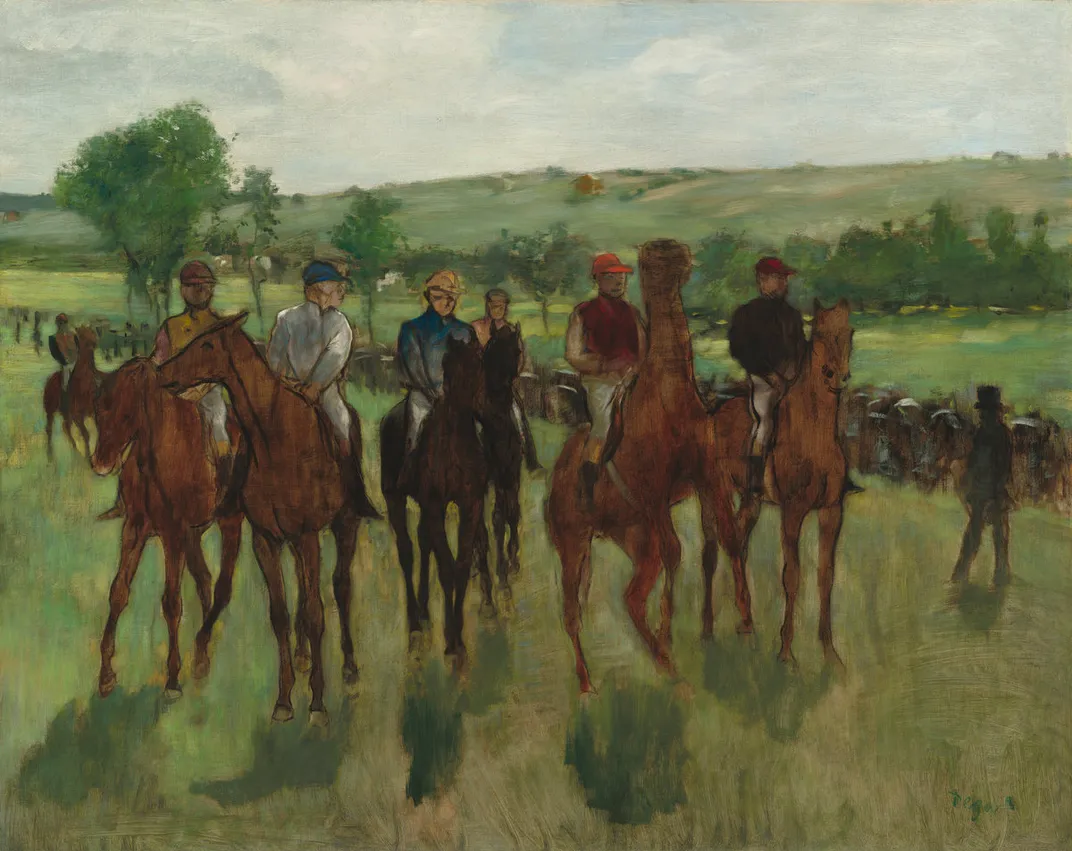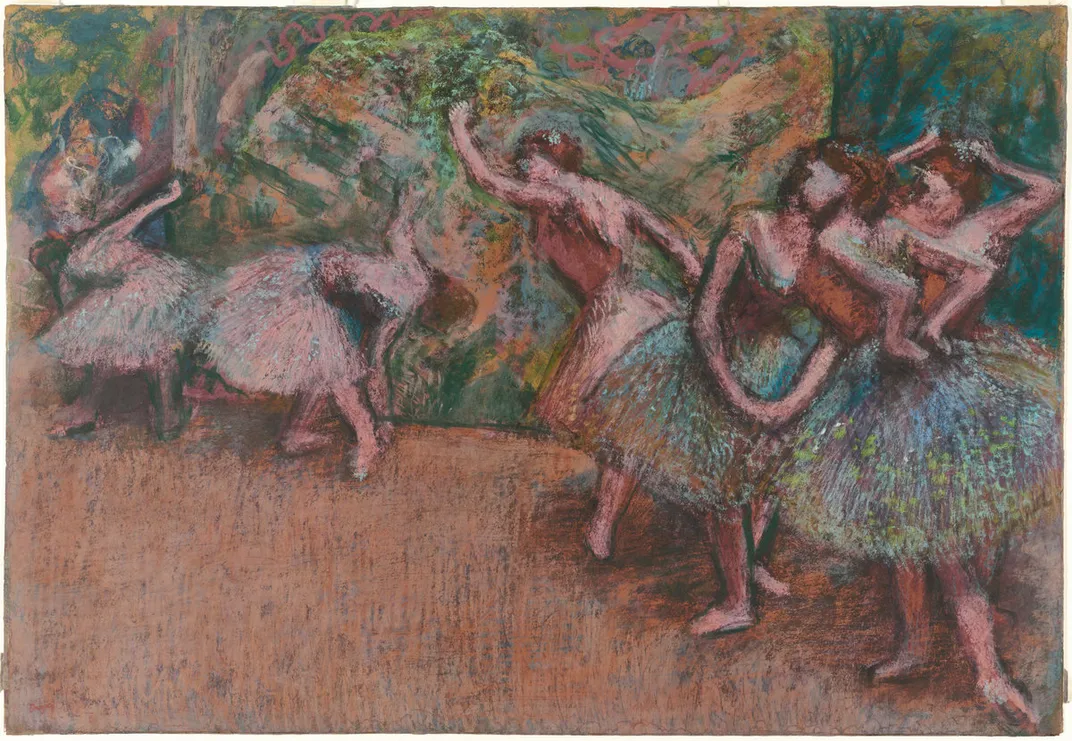One Hundred Years Later, the Tense Realism of Edgar Degas Still Captivates
For this groundbreaking artist, greatness was always one more horizon away
/https://tf-cmsv2-smithsonianmag-media.s3.amazonaws.com/filer/21/98/2198b035-7148-48fa-82b4-9253831852a6/degas1.jpg)
In the unadorned space of a high-ceilinged dance studio are assembled a bevy of young ballerinas-in-training. Clad in cascading white tutus and colorful sashes, the girls are variously occupied. In the foreground, a dancer stretching out her leg or fiddling with her dress looks down on a seated classmate, whose feet are rakishly splayed in a way that would appear natural onstage but which seems oddly grotesque in her apparent state of leisure. Resting beside her on the dark wooden bench are half a dozen unused ballet shoes.
Behind the seated girl, at the center of the image, a dancer’s rear projects into the air as she bends to adjust her own footwear. Farther back, a pair of students by the window are practicing the fifth position of the arms; for the moment, at least, they are out of sync. By the rear wall, a line of four girls is focusing on footwork. From above, two more descend into the scene via a narrow staircase, their legs the only part of them visible. It is a moment of chaos and dynamism, one capturing all the unavoidable imperfection of a childhood dance class intent on ultimately producing perfect dancers.
This tableau, painted c. 1873, is the creation of French artist Edgar Degas, who died 100 years ago this week. Housed at the National Gallery of Art in Washington, D.C., "The Dance Class" serves as an unpretentious reminder of the Parisian’s genius.
“These are real women,” says Kimberley Jones, the National Gallery’s curator of 19th-century French painting. “They’re not just the beautiful fantasy of the stage. Degas is always reminding you of the reality underneath the veneer of glamor.”
Though raised in a conservative upper-middle class home, and exceedingly well-versed in the idealistic stylings of the Old Masters—a young Degas spent hours duplicating by hand famous artworks from the Louvre—the Frenchman was always drawn to the grittiness of actuality. “He’s a realist, first and foremost,” Jones says.

Degas’s attraction to ballet was only natural; his American-born mother was a passionate opera singer, and instilled in her young boy a love for opera before her early death. “In the 19th century, ballet was part of the opera,” Jones notes. “Every opera had this sort of dance interlude. And I think he became intrigued, seeing those dancers.”
Specifically, Jones points to Degas’s fascination with the strain borne by dancers’ physiques, the rigors of their training and conditioning, the struggle to prime their bodies for showtime. “He does show performances [in his paintings],” Jones says, “and they’re very beautiful. But he also strips away a lot of the romance of it. He shows you behind the scenes.” Degas is far less concerned with notions of classical femininity, she contends, than with the rugged athleticism of trained performers.
This theme carries over to Degas’s equine work. A racetrack regular, he was enthralled by the sinewy bodies of thoroughbred racehorses, ready to snap into action at a moment’s notice. “Seeing how those gangly colts would become these incredible athletes, and these creatures of speed and elegance” never failed to make an impression, Jones says.
Repudiated early on by the art arbiters of France’s famous salon, Degas decided to throw in with the members of the budding Impressionist school, fellow tradition-buckers in need of contacts and exhibition space. Even among the Impressionists, though, Degas soon found himself a controversial outlier.
“There’s a certain irony that we always think of him as an Impressionist,” Jones notes. “He hated that term. He was very vocal about that.” Degas—who was painstaking in his attention to realist detail, and who spent untold hours revising and re-revising each of his canvases—did not appreciate the idle effortlessness implied by the term “Impressionism.” His art was not “something spontaneous, careless, thrown together,” says Jones. “He was very meticulous, thoughtful. And the great quote he said is, ‘No art is less spontaneous than mine.’”
Already a black sheep in the eyes of some Impressionists at the time of their inaugural show in 1874, Degas only courted more controversy in the years following. Fervent in his desire to bring wide-ranging talent into the fold, Degas recruited a number of outsiders whose work he admired, regardless of whether or not it cleaved to the Impressionist ideal. Degas’s embrace of fellow realists like Jean-Louis Forain and Jean-Francois Raffaelli raised eyebrows among the Impressionist clique—many feared the movement’s artistic identity was being diluted beyond recognition.

American Mary Cassatt was one invitee that Jones says was actually “a very good fit for the group overall.” Degas had first encountered Cassatt at her studio in Monmartre, and found that he was instantly taken with her work. “The first time he saw her art,” Jones says, he remarked that “There is someone who feels as I do.” This initial rendezvous, in 1877, sparked a decades-long friendship. It was Degas who introduced Cassatt (as well as other Impressionists such as Camille Pissarro) to the craft of printmaking, which she would go on to master in a way he never did.
Degas was also responsible for bringing the painting of Paul Gaugin to the attention of the art world. “You wouldn’t think of those two together,” Jones says, “yet Degas recognized Gaugin had this tremendous talent, brought him in, and supported him.” She cites as evidence of their bond Gaugin’s affectionate allusions to the work of Degas in his own scenes. In Gaugin’s "Still Life with Peonies," for instance, a pastel composition of Degas’s appears conspicuously in the background.
While the personality of Degas could be abrasive and confrontational—particularly in his later years, as his eyesight was flagging—there is no denying that he possessed a knack for bringing together remarkable individuals, and an unwavering commitment to both the creation and celebration of original, groundbreaking artwork across multiple media.
Because of his obsession with the continual refinement of his own work, Degas was loath to part with it during his lifetime. “He sold what he needed to,” Jones says, and “he didn’t exhibit much.” Degas did not skyrocket to international fame until after his death, when the canvases, sculptures and other creations littering his studio were finally made accessible to collectors.
Degas’s obsession with the pursuit of an ever-elusive perfect product was tragic, Jones says, but also integral to his art. In Degas’s renderings of horses loitering on grass and ballerinas rehearsing for their moment in the spotlight, Jones discerns a fixation on the potential—what could be, what it is on the verge of happening. Like his subjects, Jones says, Degas was constantly imagining himself in limbo, always a hair shy of greatness, always a moment away from the miraculous. “I think he was always looking at his art and thinking, ‘I could do this better,’” she says.
Tortured in life by his insatiable ambition, in death Degas became a hero to artists across the globe. One of his foremost admirers was Pablo Picasso, who was stunned by the avant-garde monotypes and other materials unveiled at the postmortem Degas studio sale, and who subsequently became an avid collector of Degas’s work.
/https://tf-cmsv2-smithsonianmag-media.s3.amazonaws.com/filer/81/0c/810c6571-bb1c-4dd6-a69c-73012e621f19/degas4.jpg)
“If I could pick one artist who is the true heir of Degas,” says Jones, “it would be Picasso.” In her view, though stylistically divergent, the two innovators are linked by the degree to which they lived and breathed their art. For them, Jones says, “Everything is about creating. Every material is an opportunity to produce something new, to challenge the boundaries, to test themselves as well. And to create something extraordinary.”
Over the course of the 20th century, Degas’s singular vision came to haunt the imaginations of artists the world over. “He becomes one of those figures like Paul Cezanne and Van Gogh, who is just there,” Jones says, “and is a cornerstone. He is central to so many artists who are not even thinking it. He’s in their hindbrain and influencing them.”
Today, walking the halls of the centuries-old Prado museum in Madrid, Spain, Jones finds her perspective inescapably colored by the Frenchman’s enigmatic work. Contemplating one of Alexandre Cabanel’s resplendent neoclassical nudes, she cannot help but feel that something crucial is wanting.
“It’s all pretense,” she says, “it’s all carefully orchestrated—it’s not real. And it feels fake, in a way that it wouldn’t have without Degas as a point of reference.”
Degas, she says, was never content to create a simple, pleasant scene and move on. He “wanted to make sure you were challenged,” just as he was during the composition process. Jones has been puzzling over the artist for decades, yet still feels as though she has only “scratched the surface.”
Artists of his caliber “don’t give up their secrets,” she says. “The more time I spend looking at him, the less I think I really know him. And that’s exciting.”
/https://tf-cmsv2-smithsonianmag-media.s3.amazonaws.com/accounts/headshot/DSC_02399_copy.jpg)
/https://tf-cmsv2-smithsonianmag-media.s3.amazonaws.com/accounts/headshot/DSC_02399_copy.jpg)